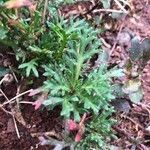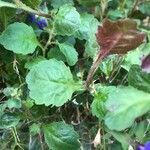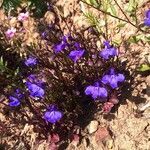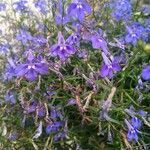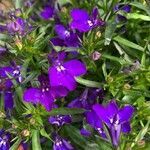Annual herb to c. 20 cm tall, sometimes single-stemmed with the slender vegetative shoots tending to trail, but not rooting at nodes; sap slightly milky. Lower lvs and those of vegetative stems with short ciliate petioles. Lamina 1-3 × 0.5-1 cm, elliptic, elliptic-obovate, or spathulate, occasionally lanceolate, generally ciliate, especially towards the narrow attenuate base and on the midrib beneath, crenate or dentate. Lvs below infl. linear or lanceolate, entire, usually glabrous. Infl. a loose raceme of few fls on slender glabrous peduncles 1.5-4 cm long. Calyx 7-12 mm long; lobes linear or subulate, = to > 2× tube, glabrous, often purplish. Corolla 1.1-1.7 cm long to apex of lobes of lower lip, usually dark or violet blue, occasionally pinkish mauve; lower lip usually with white or yellowish throat bands on either side, occasionally corolla concolorous, 3-lobed; lobes (5)-7-10 × c. (3)-5 mm, ± broad-elliptic-oblong or obovate, slanting downwards, often mucronulate. Stamens blue; lower 2 anthers bearded at apex. Capsule c. 5 mm long, narrow-obconic. Seeds c. 0.5 mm long, ellipsoid, brown, glossy.
Leaves up to 15–75(100) x (1)4–20 mm., sparsely Sérrulate to dentate, crenate or almost pinnatifid, the upper linear to narrowly elliptic, the lower sometimes ± rosulate, oblanceolate to spathulate, acute to obtuse at the apex, narrowing below into a petiole–like base or an up to 15 mm. long petiole, glabrous to pubescent on both surfaces, or ciliate at the leaf–bases only.
A herb. It can be an annual or keep growing from year to year. It is a slender erect plant. It grows 30 cm high. The leaves are scattered. They are narrow and taper to both ends. There are a few teeth along the edge. The leaves are 6 cm long by 6 mm wide. The flowers are well spaced along stalks at the ends of branches. They are blue and white.
Stamens 3–7 mm. long; filaments linear, puberulous and attached to the corolla–tube at the base; anther–tube 1·2–2·4 mm. long, ± pubescent on the back of the upper thecae, or occasionally glabrous, the two lower anthers each with a tuft of hairs and a hyaline appendage at the apex.
Flowers in lax racemes; pedicels up to 5–45 mm. long, glabrous or occasionally pubescent; bracts similar to upper stem leaves, much shorter to equalling the pedicels; bracteoles c. 0·4· 1·2 mm. long, linear, at or near the base of the pedicel, occasionally absent.
Corolla 7–13 mm. long, blue or rarely mauve or white, with two bumps in the mouth of the tube, split to 0·6–2·8(3·2) mm. from the base on the back, short pubescent or papillose on the inside of the tube, glabrous or occasionally pubescent on the outside.
Annual. Corolla tube 5-7 mm long. Flowers axillary. Pedicels 1.5-5 cm. Calyx tube 2-4 mm, lobes 3.5-11 mm. Corolla blue or violet, rarely white. Stem triangular. Leaves 1.5-5 by ⅓-1 cm, oblong lanceolate, entire to serrate.
Calyx–lobes narrowly triangular to subulate, erect or somewhat spreading, 1·2–5 mm. long, entire, glabrous or occasionally pubescent or ciliate.
Stem terete to ± triangular or ribbed, glabrous to pubescent at least below with rather rigid to very fine and soft hairs.
Seeds elliptic to broadly elliptic in outline, somewhat compressed, 0·3–0·4 mm. long, very finely striate, brown.
Hypanthium narrowly obconical to obovoid, 8–10–nerved, glabrous or occasionally pubescent.
Capsule 8–10–nerved with 2 valves ± 1 mm. long, inferior part of capsule 3–8 mm. long.
Annual or sometimes perennial, decumbent to erect herb, 5–70 cm. long or tall.
Ovary subinferior.
